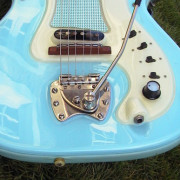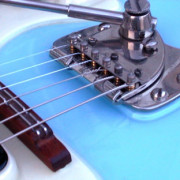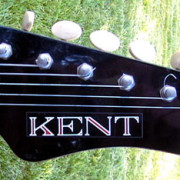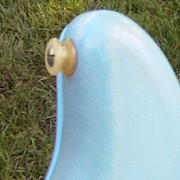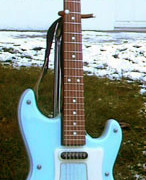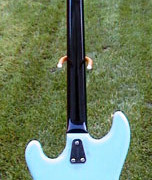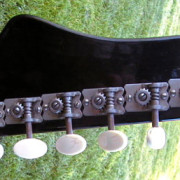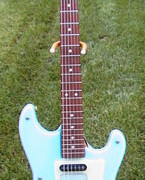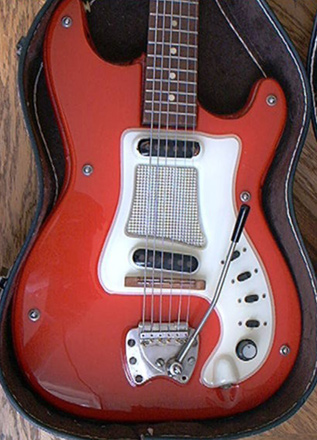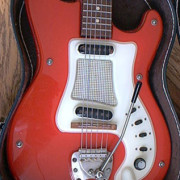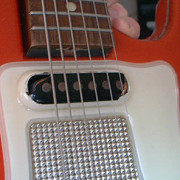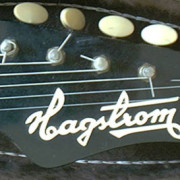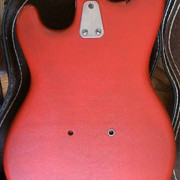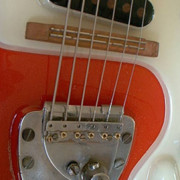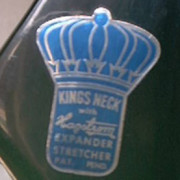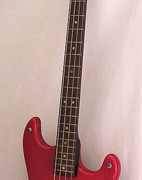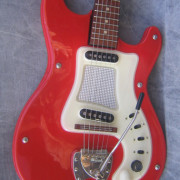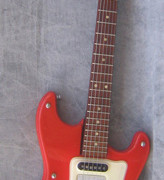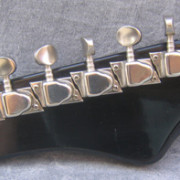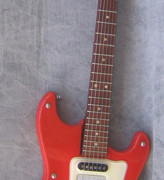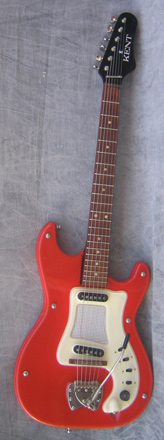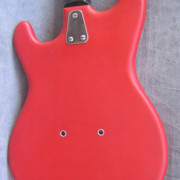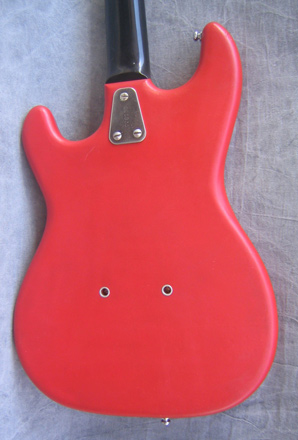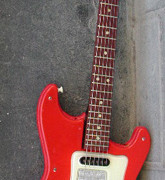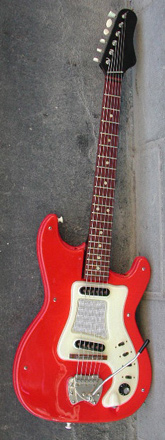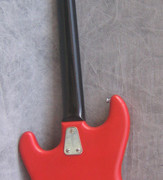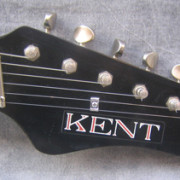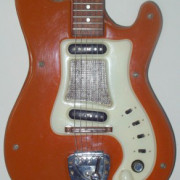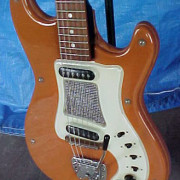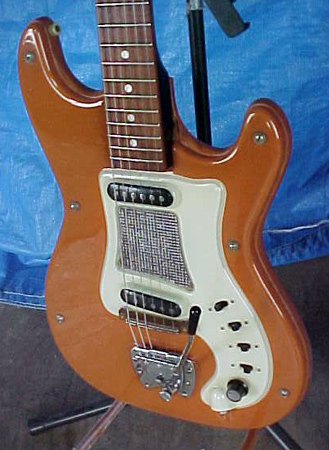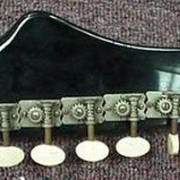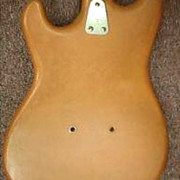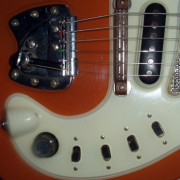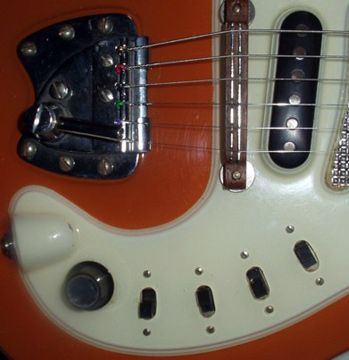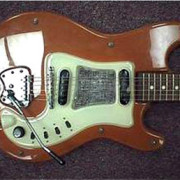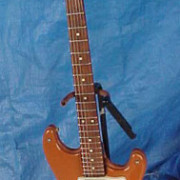1963/64 Kent
This Kent with a Kent logo has two features I very much appreciate: it is in near-perfect condition, and it’s mine. You will not see often an old pre-1964 Tremar vibrato with all its original string pegs at their place. I especially love the blue color of the grid, here it really deserves to be called a ‘swimming-pool’.
There are some changes compared to the previous versions. Fretwire is now conventional nickel-silver instead of brass and a slanted string-retainer appears on headstock. Strap buttons are made of a clear yellowish cellulosic plastic, as for nearly all Hagström guitars made in the year 1963 (including the basses, and even the first Impala, Corvette and Automatic series). Those buttons have often been replaced but if you have a Hag from the production batches 545- to 584- with such buttons you will know that they are original.
As far as playability and sound are concerned this guitar is very different from the following Hagström-I versions, is maybe better. Sound is more substantial, certainly because of the thicker neck (strangely similar to those Hagström will use in the 70’s, especially for the H-II-N).
Oh, I haven’t mentioned yet a funny feature on the back of the neck. Look at the machineheads, their fixation plates are not properly aligned because they cannot, there is not enough space for it. All first generation six-stringed Kents have that. The reason why is that the headstock had been initially designed for the first Corvette/Impala series, taking into account their much shorter tuning machines.
Questa Kent con un logo Kent ha due caratteristiche che apprezzo moltissimo: è in condizioni quasi perfette, ed è mia. Raramente si vede un vecchio vibrato Tremar pre-1964 con tutti i piroli originali al loro posto. Mi piace particolarmente il colore blù della griglia, che qui merita veramente di essere chiamata una ‘piscina’.
C’è qualche cambiamento rispetto alla versione precedente. I tasti ormai non sono più in ottone ma in classico argento-nickel, e un abbassacorde obliquo appare sulla paletta. I bottoni reggicinghia sono in plastica celluloide trasparente ingiallita, praticamente come per tutte le Hagström costruite nel 1963 (anche i bassi, e persino le prime Corvette, Impala e Automatic). Spesso sono stati sostituiti ma se avete una Hag col seriale dal 545- al 584 con questi bottoni saprete che sono originali.
Dal punto di vista della suonabilità e del suono questa chitarra è decisamente diversa dalle versioni Hagström I ulteriori, e forse migliore. La sonorità ha più sostanza e più mordente, senza dubbio grazie al manico più spesso (è stranamente simile a quelli montati da Hagström negli anni 70, particolarmente quello delle H-II-N).
Oh, non ho ancora parlato d’un divertente dettaglio dietro la paletta. Si vedano le chiavette: le placchette di fissaggio non sono allineate correttamente perché non è possibile, lo spazio disponibile non basta. È così con tutte le Kent 6 corde della prima generazione. La ragione è che questa paletta era stata disegnata inizialmente per le prime Corvette/Impala tenendo conto delle loro chiavette ben meno ingombranti.
Cette Kent à logo Kent a deux caractéristiques que j’apprécie énormément : elle est dans un état presque parfait, et elle est à moi. C’est rare de voir un vieux vibrato Tremar pré-1964 avec toutes les goupilles originales en place. J’aime spécialement la teinte bleue de la grille, qui mérite ici réellement d’être appelée une ‘piscine’.
Il y a du changement par rapport à la version d’avant. Les frettes sont en classique argent-nickel au lieu de laiton et un reteneur de cordes en biais apparaît sur la tête. Les boutons de sangle sont en plastique cellulosique transparent jauni, comme sur pratiquement toutes les Hagström de 1963 (les basses aussi, même les premières Impala, Corvette et Automatic). Ils ont souvent été remplacés mais si vous en avez une Hag des séries 545- à 584- avec ces boutons-là vous saurez qu’ils sont originaux.
En ce qui concerne le jeu et le son cette guitare est bien différente des versions Hagström I d’après, et peut-être meilleure. Le son a plus de substance et de mordant, à cause sûrement du manche plus épais (il rappelle étrangement ceux des Hagström des années 70, singulièrement celui des H-II-N)
Oh, je n’ai pas encore parlé d’un amusant détail au dos de la tête. Voyez les clés: leurs plaques de fixation ne sont pas correctement alignées parce que c’est impossible, il n’y a pas la place suffisante. Toutes les Kents 6 cordes de première génération ont ça. La raison est que la tête avait été initialement dessinée pour les premières Corvettes/Impalas en fonction de leurs mécaniques bien plus courtes.
1963 ‘Hagström’ (USA)
Once the contract with Goya was terminated in the end of 1961, Hagström guitars were absent of the U.S. market in the years 1962 and 1963. The earliest versions (those with brass frets and no string-retainer) of the early Kent are therefore pretty much unknown in North America.
Then a distribution agreement was signed with the Merson/Unicord company, starting in late 1963. Using the Kent brand was out of question in USA since it was a registered trade name of Buegeleisen & Jacobson. The guitars were therefore simply branded with a Hagström logo.
This white raised logo on headstock is absolutely USA specific (at the same time the Kent sold in Europe still had the Kent logo). It was used only for a short time in late 1963. The very rare guitars that survive from that batch are generally in poor shape. This one, all original (except for the Tremar screw and string pins), is the cleanest I have seen so far.
Dopo la fine del contratto con Goya alla fine del 1961, le chitarre Hagström furono assenti dal mercato statunitense durante gli anni 1962-1963. Le primissime versioni (quelle con tasti di ottone e senza abbassacorde) delle prime Kent sono quindi praticamente sconosciute in America del Nord.
Poi venne firmato un accordo di distribuzione con la Merson/Unicord, alla fine del 1963. Era fuori questione usare in USA il nome Kent, dove era un marchio registrato della Buegeleisen & Jacobson. Perciò le chitarre furono marchiate con un semplice logo Hagström.
Questo logo bianco in rilievo sulla paletta è assolutamente specifico degli USA (allo stesso tempo i modelli venduti in Europa avevano ancora il logo Kent). Venne brevamente usato alla fine di 1963. Le rarissime chitarre che sopravivono di questa serie di fabbricazione sono generalmente in pessima condizioni. Questa qui, tutta originale (salvo la vite del Tremar ed i piroli delle corde), è la migliore che conosco.
Oh, non ho ancora parlato d’un divertente dettaglio dietro la paletta. Si vedano le chiavette: le placchette di fissaggio non sono allineate correttamente perché non è possibile, lo spazio disponibile non basta. È così con tutte le Kent 6 corde della prima generazione. La ragione è che questa paletta era stata disegnata inizialmente per le prime Corvette/Impala tenendo conto delle loro chiavette ben meno ingombranti.
Une fois terminé fin 1961 le contrat avec Goya, les guitares Hagström furent absentes du marché US durant les années 1962-1963. Les versions primitives (avec frettes laiton et sans reteneur de cordes) des premières Kent sont de ce fait pratiquement inconnues en Amérique du Nord.
Puis, un accord fut signé avec le distributeur Merson/Unicord, fin 1963. Utiliser le nom Kent était hors de question aux USA, où il était marque déposée de Buegeleisen & Jacobson. Aussi les guitares furent-elles frappées d’un simple logo Hagström.
Ce logo blanc en relief sur la tête est absolument spécifique aux USA (à ce moment les Kent vendues en Europe avaient encore le logo Kent). Il a été brièvement utilisé fin 1963. Les très rares guitares survivantes de ce lot de fabrication sont en général en très sale état. Celle-ci, 100% originale (sauf la vis du Tremar et les goupilles de cordes), est la mieux conservée que je connaisse.
1963/64 No-Name Bass
Kent basses are (with few exceptions) in synchronous evolution with the six-stringed Kents. Both were granted their distinctive string retainer at the same time. From then on coloured grilles tend to disappear, while non branded headstocks become increasingly common.
I bassi Kent sono (con minime eccezioni) in evoluzione sincrona con le Kent 6 corde. Il distintivo abbassacorde è arrivato su entrambi allo stesso momento. La griglia colorata comincia a sparire, mentre le palette senza logo diventano più frequenti.
Les Kent basses sont (à peu d’exceptions) en évolution synchrone avec les Kents 6 cordes. Toutes deux ont reçu en même temps leur caractéristique reteneur de cordes. La grille colorée tend à disparaître, tandis que les têtes sans logo deviennent plus fréquentes.
1963/64 Red Kents
Two guitars sold by Vintage Guitars, Stockholm, Sweden. Both are red, with very close serial numbers. One is branded Kent, the other has no name. Some parts have been changed (tuners, strap buttons).
At a certain moment of 1963/64, the Kent logo becomes rarer and finally quits the scene, leaving behind an all black headstock. In Europe, this might be due to the fact that a new Kent branded model was about to be released (the ‘Wooden Kent’), but the number of no-name Kents is also noticeable in USA. Furthermore this coincides with a temporary rarefaction of the ‘King’s Neck’ label, as if Hagström wanted to sell off fully anonymous guitars. All that suggests some parallel unbranded distribution, a widespread practice then.
Photos from: http://www.vintage-guitars.se . One of the coolest places in Europe to buy and trade old valuable gear, and a fantastic photo archive with plenty of superb pics and concise but accurate information.
Due chitarre vendute da Vintage Guitars, Stoccolma, Svezia. Entrambe rosse, con numeri di serie vicinissimi, l’una targata Kent, l’altra rimasta anonima. Alcuni componenti cambiati (chiavette, bottoni reggicinghia).
A un certo punto, 1963/64, il logo Kent diventa più raro e finalmente si ritira dalla scena lasciando una paletta tutta nera. In Europa poteva esser dovuto al fatto che un nuovo modello chiamato Kent era pronto ad uscire (la ‘Wooden Kent’) ma la quantità di Kent senza marchio è notevole anche in USA. Il fenomeno coincide inoltre con una rarefazione temporanea dell’adesivo ‘King’s Neck’, come se la Hagström volesse rendere queste chitarre totalmente anonime. Tutto ciò suggerisce una distribuzione parallela non marchiata, una pratica ben diffusa allora.
Foto da: http://www.vintage-guitars.se . Un negozio fra i più cool per comprare e scambiare vecchie chitarre di qualità, con un fantatisco archivio fotografico online completo di informazioni concise ma precise.
Deux guitares vendues par Vintage Guitars, Stockholm, Suède. Toutes deux rouges, avec des numéros de série très proches, l’une marquée Kent , l’autre sans nom. Quelques pièces changées (clés, boutons de sangle).
A un certain moment de 1963/64, le logo Kent se fait plus rare et finit par quitter la scène, laissant une tête toute noire. Cela pouvait être dû au fait qu’un nouveau modèle marqué Kent était sur le point de sortir (la ‘Wooden Kent’) mais le nombre de Kent sans marque est notable aux USA également. De plus le phénomène coïncide avec une raréfaction temporaire du label ‘King’s Neck’, comme si Hagström voulait écouler des guitares complètement anonymes. Voilà qui suggère une distribution parallèle démarquée, selon une pratique alors courante.
Photos de: http://www.vintage-guitars.se . Un des endroits les plus cools pour acheter ou échanger des vieilles grattes de qualité, et une fantastique photothèque en ligne accompagnée d’infos concises mais précises.
1963-64 The Orange Wonder
This has to be the most famous early Kent around : the ORANGE one! It first showed up on the internet in 1999, then was spotted on a US dealer’s site and finally found the best possible home in John Haskin’s collection (who runs the most comprehensive Hagström site in the USA, http://www.haskinsHagströms.com )
No other Kent with this color has been reported as of yet (March 2006). In my opinion it must have been some marketing sample shipped to the USA in an attempt to start a parallel distribution, and deliberately finished in a distinctive color in order to avoid too blatant a similarity with the ‘regular’ American version’s predominantly red finish. This supposition seems to be confirmed by the fact that there is neither logo nor ‘King’s Neck’ sticker, and no evidence the guitar ever had any of them.
The first pictures (up the page) show a Tremar unit of a younger version (1965) and a MicroMatic bridge that couldn’t belong to the original appointments of the instrument. Some previous owner, for some reason, must have revamped it with newer components. The guitar has been since then restored with a real wooden Kent bridge.
Deve essere la più famosa delle primissime Kent: quella ARANCIONE! Si è vista per prima volta su Internet nel 1999, poi sul sito d’un rivenditore americano finita quindi nell’ambiente ideale, cioè nella collezione di John Haskin (che cura il più completo sito Hagström in USA,http://www.haskinsHagströms.com)
Finora non era mai stata vista nessun’altra Kent di questo colore (Marzo 2006). Secondo me siamo in presenza di un campione commerciale spedito negli USA per tentare una distribuzione parallela, deliberatamente fatto in un colore distintivo allo scopo di diminuire la somiglianza con la versione americana ‘normale’ (quella con il logo Hagström bianco sulla paletta), quasi sempre rossa. Sembra confermare questa tesi l’assenza del logo e dell’adesivo ‘King’s Neck’ e nessuna traccia che ce ne siano mai stati alcuni.
Le prime foto (sopra) mostrano un vibrato Tremar in versione posteriore (1965) e un ponticello MicroMatic che non appartevano alla dotazione originale della chitarra. Qualche precedente utente li avrà sostituiti ai pezzi originali. L’originalità della chitarra venne in seguito ripristinata con l’autentico ponte Kent in legno.
Ce doit être la plus célèbre des anciennes Kents : la Kent ORANGE! Elle a émergé sur internet en 1999, puis a figuré sur le site d’un revendeur américain, et pour finir a trouvé le meilleur foyer possible dans la collection de John Haskin (qui s’occupe du plus complet site Hagström des USA,http://www.haskinsHagströms.com )
On ne connaît à ce jour (Mars 2006) aucune autre Kent de cette couleur. A mon avis il s’agit d’un échantillon commercial envoyé aux USA pour prospecter une distribution parallèle, délibérément fait dans une couleur distincte afin de gommer la similitude avec la version américaine ‘normale’ presque toujours rouge (celle avec logo Hagström blanc sur la tête). A l’appui de cette supposition, la guitare ne comporte ni logo ni label ‘King’s Neck’, ni aucun signe qu’elle en ait jamais eu.
Les premières photos (en haut) montrent un vibrato Tremar d’une version ultérieure (1965) et un chevalet MicroMatic qui ne devraient normalement pas être là. Un précédent utilisateur a dû les substituer aux pièces originales. La guitare a par la suite été rééquipée d’un vrai chevalet en bois pour Kent.


